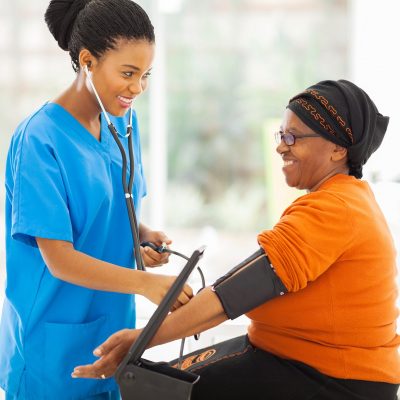 During the COVID-19 pandemic, many organizations have had to rely on telehealth and remote monitoring of patients’ blood pressure in order to provide quality care for people with hypertension.
During the COVID-19 pandemic, many organizations have had to rely on telehealth and remote monitoring of patients’ blood pressure in order to provide quality care for people with hypertension.
Two safety net giants, the Alameda Health System and the Los Angeles County Department of Health Services, quickly began to test workflows to support patient self-monitoring. In this webinar, providers from those health centers give an inside look at their early wins, obstacles, and innovative practices in self-measured blood pressure (SMBP) — a term for any blood pressure readings taken by a patient outside a clinical setting. Whether your organization is already doing SMBP monitoring or trying to make the case to try it, this webinar offers a space to learn from others.
This webinar was co-hosted by the Center for Care Innovations and Kaiser Permanente’s cardiovascular disease prevention programs: PHASE (Preventing Heart Attacks and Strokes Everyday) and TC3 (Transforming Cardiovascular Care in Our Communities).
Below you’ll find a recording of the webinar, presenters’ slides, key takeaways, and additional resources.
WHO SHOULD VIEW THIS WEBINAR?
Any providers or staff members who work with or oversee safety net patients with high blood pressure. The webinar will be especially compelling for teams that are considering or implementing a self-measured blood pressure monitoring program or any other kind of remote monitoring services.
Inside the webinar (you can jump to or repeat whichever section interests you the most with the time codes below):
0:00 – Opening Remarks & Agenda | Denise Armstorff, Coach for PHASE and TC3 programs
2:46 – Self-measured Blood Pressure Program Survey Results | Crystal Dinh, Center for Community Health and Evaluation [Download Slides]
9:55 – Presentation by Los Angeles County Department of Health Services | Laura Sklaroff [Download Slides]
26:03 – Presentation by Alameda Health System | Eric Mahone and Natalie Curtis [Download Slides]
47:25 – Q&A Session | Denise Armstorff
Four key takeaways
1. Create an interdisciplinary team to develop and test your Self-Measured Blood Pressure program.
LAC-DHS reported strong support across departments for the SMBP program, along with marked improvements in blood pressure control. Dr. Jeffrey Guterman put it succinctly: “I’m pretty convinced that we might not have been quite as successful had we not developed the toolkit with the staff who are using it.” The team was also involved in running many Plan-Do-Study-Act (PDSA) cycles to test the workflows and troubleshoot any problems that arose. At Alameda Health System’s Highland Hospital, which also saw improvements, an interdisciplinary team of medical assistants, registered nurses, and pharmacists were all involved in the process and owned different pieces of the project.
2. Collect and analyze data for health care disparities.
Leaders of the Alameda Health System (AHS), which has many elderly, low-income and very sick patients who are wary of in-person visits during the pandemic, noted that their reliance on an in-person visit to initiate SMBP had the potential to widen disparities already present in hypertension care at the health center. To ensure that such disparities are uncovered so providers can narrow gaps in care, the team is collecting data and doing analyses on racial subgroups for metrics on processes and blood pressure control.
3. Empower staff to work to the top of their license.
SMBP programs don’t have to be run by doctors: Other professionals can help free up physicians by taking charge of these initiatives. Nurses at LAC-DHS — who were among the health center’s staff most deeply involved in developing the SMBP pilot project — were enthusiastic about the program, with one reporting that being able to run a blood pressure clinic “made me feel like a professional again.” In fact, LAC-DHS shared that a key outcome from their pilot project was the joy and pride expressed by nurses with decision-making roles in the pilot project. “This has been a really positive experience for both me and the nurses. The level of autonomy and confidence in the RNs has been wonderful,” reported one frontline staffer.
4. Remote monitoring programs can significantly improve blood pressure control among safety net patients.
Since LAC-DHS kicked off its pilot in October of this year, 90 percent of the patients enrolled have already had a blood pressure visit, and 62 percent of those patients have reached their blood pressure goal. Alameda Health System also saw marked improvements, with 75 percent of patients achieving their blood pressure goal by the end of testing, compared to 60 percent at the beginning — a 25 percent increase.
Resources
From Alameda Health System: Download Slides
- Medical Assistant Standard Work: This document outlines the MA’s role in the SMBP pilot, including outreach, sample scripts, protocols, and relevant workflows.
- RN/PharmD Standard Work: This document outlines the roles for RNs and PharmDs in Alameda Health System’s SMBP pilot, including relevant workflows and protocols.
- Measure Your Blood Pressure Patient Handout. A clear, easy-to-read patient handout from AHS.
From Los Angeles County Department of Health Services: Download Slides
- SMBP Toolkit – LACDHS will be sharing their SMBP toolkit soon!
General
What’s New In Self-Measured Blood Pressure Monitoring. A July 23, 2020 webinar CCI hosted with national experts from the American Medical Association, who discussed the latest thinking on SMBP, recent changes that make it easier to be reimbursed for SMBP-related services, and AMA resources to help providers choose a validated home blood pressure measurement device.
Have questions? Follow up with our CCI team [email protected].

